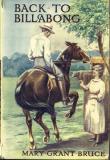AustLit
Latest Issues
AbstractHistoryArchive Description
'Trapped in London for two years as governess and servant under her nasty stepmother, petite and gentle 19-year-old Cecilia (Tommy) Rainham longs for the day the War will finish and her brother Bob will be home from the Royal Air Force to rescue her. Fortune smiles on them and a much-loved aunt’s inheritance allows them to set sail for Australia, narrowly escaping the clutches of the stepmother. Coincidentally, on the same troopship, the Linton family are making their return after five years away.
'Strong bonds of friendship form, and Billabong becomes their haven whilst they learn the ropes of station management and plan their future home. All seems rosy until the skies blacken and a bushfire all but destroys their new life. Undaunted, they pick up the pieces, and with Billabong behind them and help from willing hands, begin all over again.' (Publication summary)
Publication Details of Only Known VersionEarliest 2 Known Versions of
Works about this Work
-
“Whichever and Whatever It Was” : Rendering War and Peace in Australian WWI Narratives
2016
single work
essay
— Appears in: Long Paddock , vol. 75 no. 3 2016; 'Australian narratives of World War I (WWI) reflect a different but characteristic commemoration of that event. While the best (to modern eyes) novels of WWI present a comprehensive picture of disillusionment, futility and waste, Australian stories proffer the view that the war was worthwhile, and that the sacrifices of the Anzacs were honourable and justified. In placing WWI as a salient marker denoting the origin of the nation, Australian texts diverge from the revered WWI canon’s convincing portrayal of the war as a symbol of civilisation’s demise. Even accepting this divergence, however, there is much in Australian narratives that amplifies the memorialisation of the war in Australian society.' (Introduction) -
Back to Back to Billabongg
1993
single work
criticism
— Appears in: Australian Children's Literature : Finding a Voice 1993; (p. 18-26) -
Back to Billabong
1921
single work
review
— Appears in: The Queenslander , 24 December 1921; (p. 3)
— Review of Back to Billabong 1921 single work children's fiction
-
Back to Billabong
1921
single work
review
— Appears in: The Queenslander , 24 December 1921; (p. 3)
— Review of Back to Billabong 1921 single work children's fiction -
Back to Back to Billabongg
1993
single work
criticism
— Appears in: Australian Children's Literature : Finding a Voice 1993; (p. 18-26) -
“Whichever and Whatever It Was” : Rendering War and Peace in Australian WWI Narratives
2016
single work
essay
— Appears in: Long Paddock , vol. 75 no. 3 2016; 'Australian narratives of World War I (WWI) reflect a different but characteristic commemoration of that event. While the best (to modern eyes) novels of WWI present a comprehensive picture of disillusionment, futility and waste, Australian stories proffer the view that the war was worthwhile, and that the sacrifices of the Anzacs were honourable and justified. In placing WWI as a salient marker denoting the origin of the nation, Australian texts diverge from the revered WWI canon’s convincing portrayal of the war as a symbol of civilisation’s demise. Even accepting this divergence, however, there is much in Australian narratives that amplifies the memorialisation of the war in Australian society.' (Introduction)
- Northern Victoria, Victoria,
- Bush,



